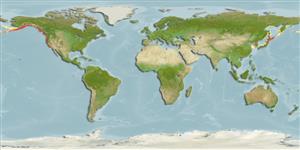>
Perciformes/Cottoidei (Sculpins) >
Rhamphocottidae (Grunt sculpins)
Etymology: Rhamphocottus: Greek, rhamphos = bill, peak + Greek, kottos = a fish without identificaction (Ref. 45335).
Eponymy: Sir John Richardson (1787–1865) was a Scottish naval surgeon, naturalist and Arctic explorer. [...] (Ref. 128868), visit book page.
More on author: Günther.
Environment: milieu / climate zone / depth range / distribution range
Ecologia
marinhas demersal; intervalo de profundidade 0 - 165 m (Ref. 2850). Temperate; 66°N - 32°N
North Pacific: Japan to Alaska and at least Santa Monica Bay, southern California, USA.
Tamanho / Peso / Idade
Maturity: Lm ? range ? - ? cm
Max length : 8.9 cm TL macho/indeterminado; (Ref. 48784)
Descrição suscinta
Chaves de identificação | Morfologia | Morfometria
Espinhos dorsais (total) : 7 - 8; Raios dorsais (total) : 12 - 13; Espinhos anais: 0; Raios anais : 6 - 7. Caudal fin well rounded.
Inhabits intertidal areas and to 165 m depth, in tide pools and rocky areas but also sand bottoms (Ref. 2850). Frequently observed taking shelter in empty shells, including those of the giant barnacle, Balanus nubilis, and discarded bottles and cans (Ref. 48784). Young feed on zooplankton and invertebrate and fish larvae; adults feed also feed on crustaceans (Ref. 28499). May use its pectoral fins to crawl over rocks and seaweed (Ref. 6885).
Ciclo de vida ou comportamento de acasalamento
Maturidade | Reprodução | Desova | Ovos | Fecundidade | Larvas
A female chases a male into a rock crevice. She keeps him there until she lays her eggs (Ref. 28499).
Robins, C.R., R.M. Bailey, C.E. Bond, J.R. Brooker, E.A. Lachner, R.N. Lea and W.B. Scott, 1991. Common and scientific names of fishes from the United States and Canada. Am. Fish. Soc. Spec. Publ. (20):183 p. (Ref. 3814)
Status na Lista Vermelha da UICN (Ref. 130435: Version 2024-1)
Ameaça para os humanos
Harmless
Uso pelos humanos
Pescarias: espécies comerciais; Aquário: Aquários públicos
Ferramentas
Relatórios especiais
Baixar XML
Fontes da internet
Estimates based on models
Preferred temperature (Ref.
123201): 4.7 - 15.9, mean 8.9 °C (based on 558 cells).
Índice de diversidade filogenética (Ref.
82804): PD
50 = 1.5000 [Uniqueness, from 0.5 = low to 2.0 = high].
Bayesian length-weight: a=0.01995 (0.00906 - 0.04395), b=3.01 (2.83 - 3.19), in cm total length, based on all LWR estimates for this body shape (Ref.
93245).
Nível Trófico (Ref.
69278): 3.4 ±0.37 se; based on food items.
Fishing Vulnerability (Ref.
59153): Low vulnerability (10 of 100).
